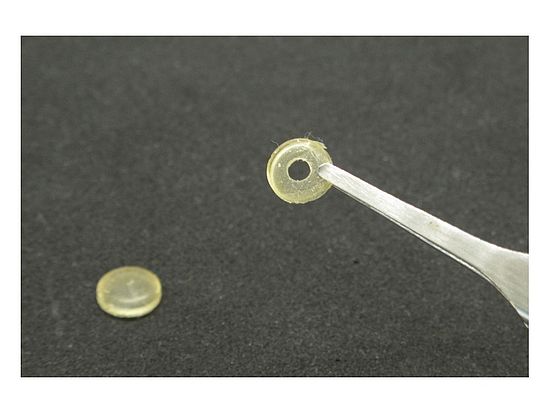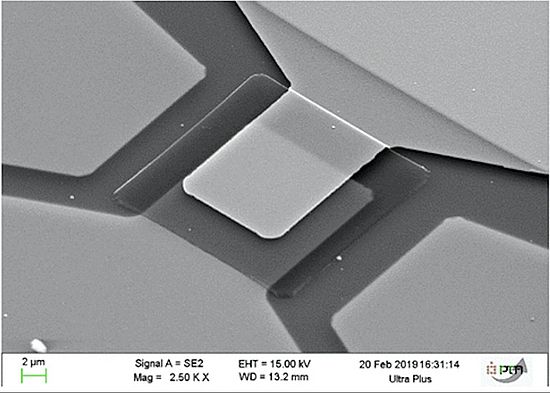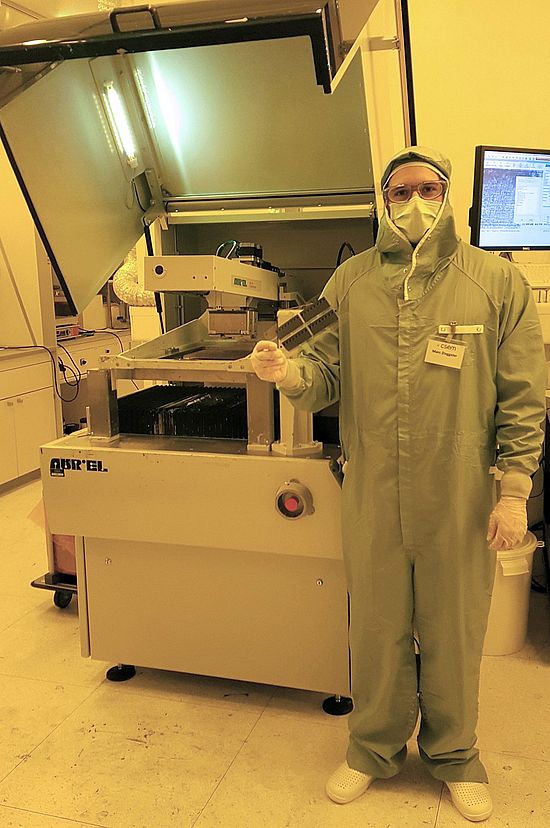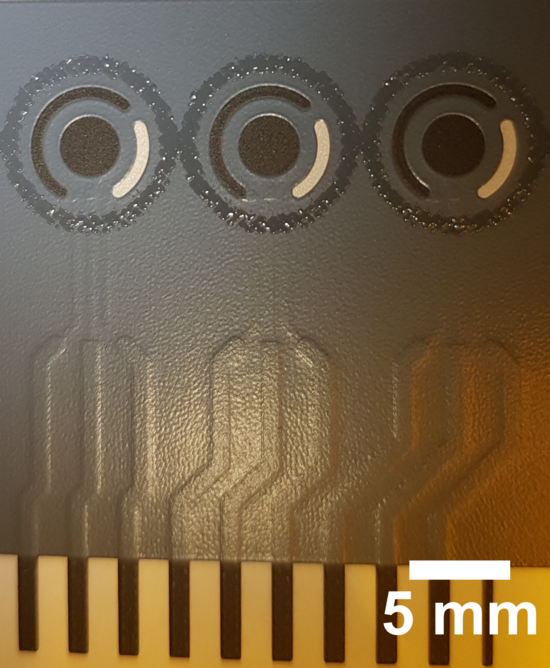Argovia Projects 2021
The following projects started in 2021.
| PROJECT | PROJECT LEADER | COLLABORATORS | |
|---|---|---|---|
| 16.01 ACHROMATIX - Development of Achromatic X-ray Lenses for Laboratory Transmission X-ray Microscopy | Dr. Joan Vila-Comamala (PSI) | Dr. Georg Schulz (University of Basel (BMC)) Prof. Dr. Bert Müller (University of Basel (BMC)) Dr. Christian David (PSI) Dr. Florian Döring (XRnanotech GmbH, Untersiggenthal) | |
| 16.04 HPDET-EM - Novel detectors for cryo electron microscopy | Prof. Dr. Timm Maier (University of Basel, Biozentrum) | Dr. Mohamed Chami (University of Basel, Biozentrum) Prof. Dr. Michael Steinmetz (PSI) Dr. Sacha De Carlo (Dectris Ltd. Baden-Dättwil) | |
| 16.05 Hydrogel patch - Peptide hydrogel patch for lesion coverage in oral mucosa | Dr. Lucy Kind (FHNW Muttenz) | Prof. Dr. Oliver Germershaus (FHNW Muttenz) Prof. Dr. Falko Schlottig (FHNW Muttenz) Michael Hug (Credentis AG, Windisch) Prof. Dr. med. dent. Michael Bornstein (University of Basel, Clinic for Oral Health and Medicine) | |
| 16.06 LanakPro - Laser nanostructuring with acoustic process control | Armin Stumpp (FHNW Windisch) | Prof. Dr. Matthias Hoebel (FHNW Windisch) Dr. Frank Dieterle (FHNW Muttenz) Dr. Markus Ehrat (Orvinum AG, Magden) | |
| 16.07 LIGARECO - Microstructured and biofunctionalized hydrogel-based periodontal LIGAment RECOnstitution device | Dr. Joachim Köser (FHNW Muttenz) | Dr. Khaled Mukaddam (University of Basel, Dentistry) Prof. Dr. Sebastian Kühl (University of Basel, Dentistry) Dr. Stefano Tugulu (Novonexile AG, Füllinsdorf) | |
| 16.10 Nanocompass - Nanoscale magnetometer with nano Tesla resolution | Prof. Dr. Joris Pascal (FHNW Muttenz) | Prof. Dr. Stefan Gorenflo (FHNW Windisch) Thomas Keusch (Camille Bauer Metrawatt AG, Wohlen) | |
| 16.11 NanoLase - Nanomachining with novel low cost, compact sub-100 fs TiSa laser amplifier | Prof. Dr. Bojan Resan (FHNW Windisch) | Dr. Alexandre Trisorio (PSI) Stephan von Wolff (TLD Photonics AG, Wettingen) | |
| 16.12 NANO-thru-BBB - Combinatorial Nanoparticle Design for Efficient Delivery of Therapeutic Enzymes through the Blood Brain Barrier | Prof. Dr. Patrick Shahgaldian (FHNW Muttenz) | Prof. Dr. Laura Suter-Dick (FHNW Muttenz) Prof. Dr. Jörg Huwyler (University of Basel, Pharma Center) Dr.-Ing. Yves Dudal (Perseo Pharma AG, Muttenz) | |
| 16.13 PEPS - Printed electrochemical protein sensor | Dr. Marc Zinggeler (CSEM Muttenz) | Dr. Silvia Generelli (CSEM Muttenz) Prof. Dr. Daniel Gygax (FHNW Muttenz) Dr. Mathias Wipf (MOMM Diagnostics GmbH, Basel) | |
16.01 ACHROMATIX - New lenses for X-ray examinations
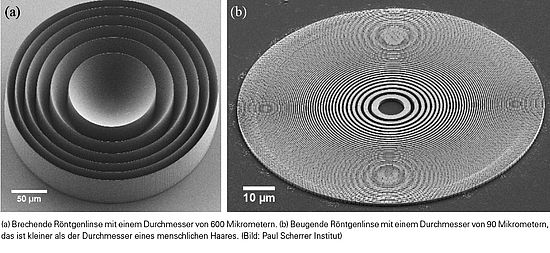
In the Nano Argovia project ACHROMATIX, an interdisciplinary team of researchers is developing a novel lens system that can be used for scientific investigations using X-rays. Dr. Joan Vila-Comamala of the Paul Scherrer Institutee is leading the project in which scientists from the Paul Scherrer Institutee, the University of Basel and the company XRnanotech are contributing their expertise.
Nowadays, X-rays play an important role not only in everyday medical practice; the special properties of X-rays are also used in research or in material analyses. In X-ray microscopy, lenses are used to focus the X-ray beam on the sample or to create a magnified image. For this purpose, various lenses have been developed in recent years that reflect, refract or diffract the X-rays. These three different types of lenses have advantages and disadvantages.
Differences depending on wavelength
Refractive and diffractive lenses focus X-rays of different wavelengths at different distances. Experts refer to this as chromatic aberration. If X-ray tubes are used as the source of X-ray radiation, it is therefore necessary to reduce the comparatively broad wavelength range using a monochromator. However, this greatly reduces the number of light particles (photons), which in turn limits the use of the X-ray tube for X-ray microscopy.
"The heart of any microscope is its optics. With new and better optics, unimagined insights into materials and matter can be achieved and new knowledge gained. The Nano-Argovia project offers us the opportunity to decisively improve optics for X-ray microscopes."
Dr. Florian Döring, CEO and founder of XRnanotech GmbH
Combination of lenses
In the Nano Argovia project ACHROMATIX, scientists are now developing a combination of a refractive and a diffractive lens. The aim is to design this lens combination in such a way that the chromatic aberration of the two lenses balances out.
First, the researchers determine the best lens combination based on theoretical calculations, which they will then manufacture using state-of-the-art nanofabrication techniques. The finished achromatic X-ray lens will then be characterized and tested in detail.
The lens will later be used for transmission X-ray microscopy to perform biomedical laboratory studies. The researchers expect this to result in an approximately tenfold improvement in photon flux. Investigations that are currently only possible using a synchrotron light source should become possible using X-ray tubes with the new lens, thereby significantly advancing and broadening the use of X-ray investigation for scientific purposes.
In addition to the project leader Dr. Joan Vila-Comamala (PSI), Dr. Christian David (PSI), Dr. Georg Schulz (Department Biomedical Engineering, University of Basel), Professor Bert Müller (Biomaterial Science Center, University of Basel) and Dr. Florian Döring from XRnanotech (Villingen) are involved as partners in the project.
Further information:
XRnanotech
https://www.xrnanotech.com/
Paul Scherrer Institute
https://www.psi.ch/de
Biomedical Science Center University of Basel
https://www.bmc.unibas.ch/index/index.phtml
16.04 HPDET-EM - A new hybrid pixel detector for cryo-electron microscopy
In the Nano Argovia project HPDET-EM, electron microscopy experts from the University of Basel and the Paul Scherrer Institute, led by Professor Timm Maier (Biozentrum, University of Basel), are collaborating with the team of Dr. Sacha de Carlo from DECTRIS AG (Baden-Dättwil) to install and test a new hybrid pixel detector. The new device will be very specific to the particularities of cryo-electron microscopy (cryo-EM), continuing the success story of cryo-EM in the life sciences.
Three-dimensional structure
Cryo-electron microscopy has evolved tremendously in recent years. New methods of data processing and improved electron detection cameras have led to the identification of individual amino acids. With the help of data from cryo-EM analyses, it is now possible to determine the three-dimensional structure of proteins. This is necessary, for example, to understand life processes and the development of diseases, or to develop new drugs.
In contrast to X-ray crystallography, which is still mainly used to identify the spatial protein structure, cryo-EM analysis does not require crystallization of the protein. Thanks to the Nobel-Prize-winning cryo-EM method developed by Swiss professor Dr. Jacques Dubochet, the sample is shock-frozen, causing water to solidify into amorphous ice at lightning speed. The sample is then analyzed from different directions, and computer programs calculate the three-dimensional electron density. This then leads to the identification of the spatial structure. The disadvantages of cryo-EM are the high cost of modern electron microscopes and detectors as well as the time required for the analyses.
"We think that our collaboration aiming at the integration of this promising detector technology into your life sciences cryo-EM workflows as well as your established network within the life sciences and EM community will help DECTRIS reach this important new market segment."
Dr. Sacha de Carlo, Global Sales Manager EM at Dectris
Better for Cryo-EM
Scientists in the Nano Argovia HPDET-EM project are now testing a hybrid-pixel detector that better meets the requirements of cryo-electron microscopy than models used for synchrotron and X-ray analyses. DECTRIS, the world leader in hybrid pixel detectors, is collaborating with University of Basel specialists Professor Timm Maier and Dr. Mohamed Chami as well as Professor Michael Steinmetz of the Paul Scherrer Institute.
In hybrid pixel detectors, a semiconductor sensor and the readout chip are optimized and fabricated independently and then electrically coupled. In the process, individual modules are strung together.
The researchers are now installing and testing a new hybrid pixel detector developed by DECTRIS that has high readout speed and sensitivity. They are developing the necessary protocols for operation and analysis in conjunction with cryo-EM to further advance the technology for application in the life sciences.
Further information:
DECTRIS
https://www.dectris.com/
Paul Scherrer Institute
https://www.psi.ch/de
Biozentrum, University of Basel
https://www.biozentrum.unibas.ch/
16.05 Hydrogel patch -Treatment for ulcers in the oral mucosa

Transmission electron image of the peptide hydrogel that could be used to treat nonspecific ulcers in the mouth. (Image: L. Kind, FHNW)
As part of the Nano Argovia project Hydrogel-Patch, an interdisciplinary team led by Dr. Lucy Kind (University of Applied Sciences Northwestern Switzerland, FHNW) is working with the company credentis AG (Windisch) to develop a plaster for use on nonspecific ulcers in the oral mucosa. The plaster consists of a synthetic, self-assembling peptide hydrogel that initially covers the affected areas and is potentially also suitable for releasing therapeutic agents.
A need for comprehensive therapy
Wounds in the oral mucosa can have a variety of causes, including injuries, infections, reduced immune responses and tumors. Nonspecific ulcers are often caused by a combination of different factors. Whatever their origin, these wounds cause pain during eating or speaking and therefore negatively impact patients’ quality of life. Ideally, there would be a treatment that could be applied directly within the mouth and that relieved pain, supported the healing process and was produced without ingredients of animal origin.
Now, the team of researchers is planning to test a synthetic peptide hydrogel that meets these requirements. The hydrogel in question consists of synthetic, self-assembling peptides that adhere to soft, moist tissue. This fibrous network can be cross-linked by various substances to deliver greater stability.
The technology is already being used for other applications in dentistry, such as the controlled regeneration of enamel, and exhibits excellent compatibility with surrounding tissue.
"Over a decade, we have been working successfully with the FHNW. Every credentis product contains a piece of Northwestern Switzerland. In the SNI cooperation with the University of Basel and the FHNW, we would like to go one step further and explore new indications in the oral care field. We expect this to lead to innovative and intelligent regeneration systems in the field of soft tissue management."
Michael Hug, CTO at credentis AG
Building on experience
In the PERIONANO Nano-Argovia project, researchers from the SNI network already investigated the use of hydrogel to treat inflammation on dental implants.
In the new Nano-Argovia project Hydrogel-Patch, the scientists are now testing various methods and substances that crosslink and thus stabilize the hydrogel. They are looking at how the hydrogel adheres to the moist oral tissue and how washout can be prevented. Biocompatibility and the integration of nanocapsules that release active ingredients are also topics of investigation for the project team.
In addition to project leader Dr. Lucy Kind, the teams of her FHNW colleagues Prof. Dr. Oliver Germershaus and Prof. Dr. Falko Schlottig, as well as Prof. Dr. Michael Bornstein from the University Center for Dental Medicine at the University of Basel and Michael Hug from credentis AG are involved.
Further information:
credentis AG
https://www.credentis.com
University of LIfe Sciences (FHNW)
https://www.fhnw.ch/de/die-fhnw/hochschulen/lifesciences
University Center for Dental Medicine of the University of Basel
https://www.uzb.ch/
16.06 LanakPro - Acoustic signal to control laser structuring processes
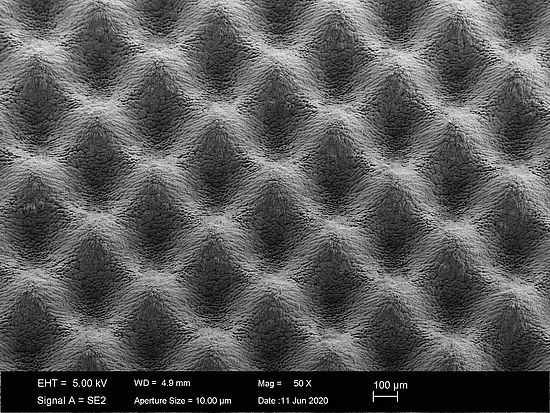
Researchers working on the Nano Argovia project LanakPro have a plan to use acoustic signals to control laser structuring processes – here a titanium surface. (Image: A. Stumpp, Institute of Product and Production Engineering, FHNW)
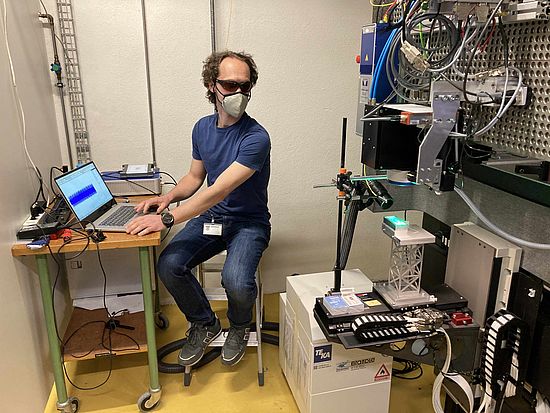
Claudio Furrer is part of the project team. (Image: A. Stumpp, Institute of Product and Production Engineering, FHNW)
As part of the Nano Argovia project LanakPro, teams from the University of Applied Sciences and Arts Northwestern Switzerland (FHNW) are working with the industrial partner Orvinum AG (Magden) to achieve effective and reliable control of laser nanostructuring processes. The planned instrument will use acoustic signals that provide quick and reliable information on the progress and quality of processing, allowing researchers to control the nanostructuring process.
There is an increasingly wide range of applications for materials whose surfaces exhibit special properties thanks to the presence of miniscule structures. These microstructures and nanostructures are often produced using lasers, but the structuring processes require elaborate monitoring and control. Ideally, there would be an instrument that provided automated process monitoring and independent tracking in order to pave the way for widespread applications in areas such as microfluidics, medical engineering or sensor technology.
Recording an acoustic fingerprint
Under the leadership of Armin Stumpp (FHNW), the team behind the Nano Argovia project LanakPro is now using acoustic signals to enable control of the structuring process. To do this, they first record an “acoustic fingerprint” of the optimum structuring process, which can then be compared with the true signal pattern in real time when it comes to measuring a real sample. Thanks to new, fast and robust algorithms and an underlying database, it will then be possible to register deviations immediately, intervene in the process and make the necessary adjustments.
The participating researchers from the teams led by Armin Stumpp, Professor Matthias Hoebel, Claudio Furrer (all of the FHNW School of Engineering), Dr. Frank Dieterle (FHNW School of Life Sciences) and Dr. Markus Ehrat (Orvinum AG) are developing this instrument in order to improve development times and processing costs for laser nanostructuring processes. Their focus is on applications with particularly stringent requirements in terms of processing quality and efficiency, especially those involving materials such as glass or plastics and sensitive substrates such as ceramics.
Multiple steps are required
Over the next few months, the project team will now select suitable sensors, taking care to ensure that they offer a high level of sensitivity in the relevant frequency ranges. The team will then record the acoustic fingerprints for various materials during laser structuring and filter out key signals for the process sequence before carrying out the first laser structuring processes with acoustic monitoring.
Based on this work, the researchers then plan to develop a device that allows even users who lack special training to carry out sophisticated laser processes for various substances quickly and in a reproducible manner.
"The process monitoring developed as part of this project will have a beneficial impact on the precision, robustness and duration of processing and therefore open up new applications for laser nanostructuring."
Markus Ehrat, CSO at Orvinum AG
Further information:
Orvinum AG
https://www.wine-rarities.com/
School of Engineering (FHNW)
https://www.fhnw.ch/Plone/de/die-fhnw/hochschulen/ht
School of LIfe Sciences (FHNW)
https://www.fhnw.ch/de/die-fhnw/hochschulen/lifesciences
16.07 LIGARECO - Hydrogel template for a better integration into soft tissue

Jaw with two implants. Left: unguided soft-tissue growth around an implant; right: a diagram of the hydrogel template with growth channels. This template is inserted between the bone and the exposed soft tissue during implantation. (Image: K. Mukaddam, UZB, FHNW)
In the Nano Argovia project LIGARECO, researchers from the University of Applied Sciences and Arts Northwestern Switzerland (FHNW), the University of Basel and the industrial partner NovoNexile AG are investigating the prophylactic use of a hydrogel template to prevent inflammation around dental implants. The project is led by Dr. Joachim Köser (FHNW) and Dr. Khaled Mukaddam (University of Basel).
Lack of integration
Nowadays, the placement of dental implants is an everyday procedure at dental practices, with implants offering numerous advantages for patients. Sooner or later, however, one in four cases is affected by inflammation around the implant (peri-implantitis), which can sometimes even result in the loss of the implant. These inflammatory processes can be attributed to a lack of integration of the implant into the surrounding soft tissue. Until now, efforts have focused on anchoring the implant safely and securely into the bone, but it is also necessary to ensure an optimum connection between the soft tissue and the implant.
In the case of a natural tooth, a structure consisting of radial collagen fibers, known as the peridontal ligament, creates a stable connection between the tooth and the surrounding tissue. With implants, these bundles of collagen are sometimes also formed on the soft-tissue side, but they generally have a different orientation than they would with a natural tooth. The bond is mechanically weaker and can allow the entry of inflammatory bacteria.
Anchor into the soft tissue
In the Nano Argovia project LIGARECO, the aim is now to develop an absorbable, microstructured hydrogel template that is designed to stimulate the targeted formation of collagen fibers around dental implants. Like with a natural tooth, these fibers are intended to anchor the implant collar into the surrounding soft tissue more effectively in order to form a barrier that prevents the entry of bacteria and therefore protects the implant against bacterial infections.
In addition to the two project leaders – Dr. Joachim Köser (FHNW School of Life Sciences) and Dr. Khaled Mukaddam (University Center for Dental Medicine Basel, UZB) – the project team also includes Professor Sebastian Kühl (UZB) and Dr. Stefano Tugulu from NovoNexile AG (Füllinsdorf, Basel-Landschaft). The researchers are initially investigating the production of the hydrogel template. They will then turn their attention to the functional microstructuring and nanostructuring of the hydrogels, which control the settlement of ligament-forming cells and the formation of the desired fibers.
"The Nano Argovia program is a valuable opportunity to work with two leading regional institutions, in the form of the FHNW and the University of Basel, in order to develop the next generation of functional biomaterials."
Dr. Stefano Tugulu, Founder and Director of NovoNexile AG
Further information:
NovoNexile AG
http://novonexile.com/
School of Life Sciences (FHNW)
https://www.fhnw.ch/de/die-fhnw/hochschulen/lifesciences
University Center for Dental Medicine Basel
https://www.uzb.ch/
16.10 Nanocompass - Nanoscale magnetic field sensor
An interdisciplinary team is cooperating closely to develop a novel magnetic field sensor. The planned sensor will be much smaller than commercially available ones, but will nevertheless be suitable for mass production. Under the coordination of Professor Joris Pascal, researchers from the School of Life Sciences, the School of Engineering and industry partner Camille Bauer Metrawatt AG (Wohlen, AG) will combine known principles in search of a way to produce minute magnetometers with potential applications in a variety of fields, including magnetic cameras, quality control or medical technology.
Sensor for magnetic field
A traditional compass is nothing other than a magnetic sensor. The compass needle reacts to the Earth’s magnetic field, causing it to point north. Countless other magnetic field sensors are at work in our everyday life – for the most part, without our realizing it. In a modern automobile, for instance, some 70 magnetic field sensors are responsible for ensuring safety, control and comfort. Mobile phones employ microelectronic magnetic sensors that help determine the device’s location, while in medical technology magnetic sensors are already used to monitor the activity of pacemakers and drug delivery systems.
"The Nanocompass project opens up new industrial prospects, especially for contactless measurement of electric currents."
Thomas Keusch, Head of Research & Development at Camille Bauer Metrawatt
Nanoscale and suitable for mass production
The team working on the Nano Argovia project Nanocompass now hopes to develop the first nanoscale magnetic field sensor that can be produced using a widely available industrial manufacturing process. To this end, the researchers – led by Professor Joris Pascal (FHNW School of Life Sciences), Professor Stefan Gorenflo (FHNW School of Engineering) and Thomas Keusch (Camille Bauer Metrawatt AG) – will combine two well-known principles: The fluxgate principle, which to date has mostly been used in macroscopic sensors, will be implemented on a spintronic component.
The first nanoscale magnetic field sensor will be extremely compact, requiring very little electricity and allowing industrial mass production. This will make it possible to implement a large number of magnetic field sensors, along with their conditioning and processing electronics, on a single chip, enabling a broad range of applications in numerous fields.
Further information:
Camille Bauer Metrawatt AG
https://www.gmc-instruments.ch/
School of LIfe Sciences (FHNW)
https://www.fhnw.ch/de/die-fhnw/hochschulen/lifesciences
School of Engineering (FHNW)
https://www.fhnw.ch/Plone/de/die-fhnw/hochschulen/ht
16.11 NanoLase - New ultrashort pulse laser source for nano-materials processing

Experimental setup of the femtosecond laser. Blue light is emitted from the new pump diodes. (Image: B. Resan, FHNW)
In the Nano Argovia project NanoLase, a team from the School of Engineering (FHNW), the Paul Scherrer Institute and the company TLD Photonics AG (Wettingen, AG) is developing a novel laser source that generates ultrashort pulses. The new device is expected to be more cost-effective, reliable and compact compared with existing laser systems. It will also generate several times shorter pulses compared with current industrial lasers enabling transition from laser micromachining to laser nanomachining. In addition to industrial materials processing, such a laser source would be very beneficial in life sciences and numerous other scientific applications.
Different parameters
Today, lasers are used to process a variety of materials. The wavelength, average power, pulse energy and pulse duration of the laser are parameters that must be adapted to the particular material and project and are decisive for the result of the processing. How much the material heats up and degrades the quality of the microstructure, and the amount of material removed by the laser in the process, are determined primarily by the duration of the laser pulse and the irradiance.
If heat generation is to be reduced to a very small zone (heat-affected zone < 1 micrometer) when processing with a laser, pulses of extremely short duration of less than 100 femtoseconds (1 femtosecond = 10-15 seconds) are required. Until now, this was only possible using scientific laser setups in the scientific labs and low power. This leads to results that are not reproducible and long processing times that are not acceptable for industrial applications.
Shorter pulses
In the Nano Argovia project NanoLase, the teams of project leader Professor Bojan Resan (FHNW), Dr. Alexandre Trisorio (PSI) together with industry partner Stephan von Wolff (TLD Photonics AG) are pursuing a new approach that allows higher precision processing due to shorter pulses, for polymers and glass with lasers with emission wavelength in the infrared range, and for metals with the laser wavelength converted to the UV region.
The researchers aim to achieve this by developing a laser amplifier made of titanium-doped sapphire with a new single-crystal geometry (SCF). The SCF geometry enables manifold increase in the average laser output power due to higher efficiency cooling. In addition, the scientists will use novel low-cost blue laser diodes with a wavelength of 445 nanometers (mass produced for displays and the car industry) to pump titanium-doped sapphire lasers, which will make the lasers compact, low cost and industrial grade.
The results of this project are expected to address the current lack of compact, low-cost and reliable lasers that produce high power and ultrashort pulses suitable for industrial micro- and nano-machining.
"The NanoLase project is very exciting and promising for TLD Photonics as it helps to develop new technology, as well as to demonstrate its use in materials processing. It will bring the new product line to TLD Photonics, which could represent a breakthrough from laser micro- to laser nano-machining."
Stephan von Wolff, CEO of TLD Photonics AG
Further information:
TLD Photonics
https://tld-photonics.odoo.com/de/
School of Engineering (FHNW)
https://www.fhnw.ch/Plone/de/die-fhnw/hochschulen/ht
Paul Scherrer Institute
https://www.psi.ch/de
16.12 NANO-thru-BBB - Crossing the blood-brain barrier
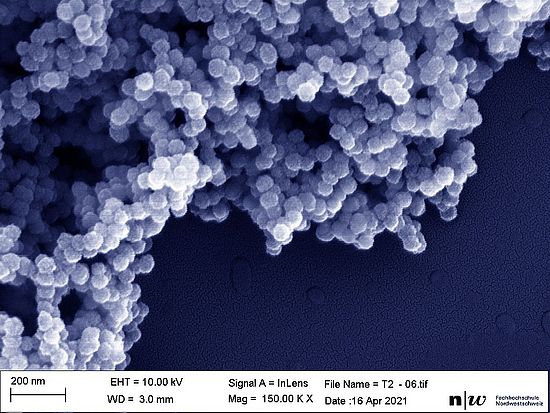
In the Nano Argovia project Nano-thru-BBB, scientists are developing a new technological platform that will enable the design of nanoparticles that have the potential to pass the blood-brain barrier. (Image: Perseo pharma)
In the Nano Argovia project NANO-thru-BBB, an interdisciplinary team led by Professor Patrick Shahgaldian (FHNW) is developing a platform to design nanoparticles that can cross the blood-brain barrier (BBB). The project involves researchers from the School of Life Sciences (FHNW), the University of Basel and the industrial partner Perseo Pharma AG (Muttenz).
Selective entry
The blood-brain barrier is a complex, selective barrier that protects the brain from harmful substances or pathogens found in the bloodstream. Nutrients needed by the brain enter the brain only through specific, controlled transport processes, while numerous macromolecules are denied entry. Biological therapeutics that could be used to treat neurological diseases in the brain are also generally unable to cross the blood-brain barrier.
However, nanoparticles in which these biological macromolecules are “packaged” can pass the barrier under certain circumstances. To date, however, no study exists that systematically identifies which surface properties the optimal nanotransporters should have.
Interdisciplinary team
The research groups of Professor Patrick Shahgaldian, Professor Laura Suter-Dick (both FHNW), Professor Jörg Huwyler (University of Basel) and Dr. Yves Dudal and Dr. Emilie Laprévotte (both Perseo pharma) are now planning to develop a new technological platform that will enable an optimized design of such nanoparticles.
Based on a novel method of combinatorial surface modification, the researchers will study the chemical structure and nanoparticle design and test them on cellular BBB models (in vitro) and on zebrafish models (in vivo). Supported by computer analyses, the scientists will be able to determine the most appropriate nanoparticle structure that enables passage through the blood-brain barrier.
Specifically, the project aims to introduce enzymes into the brain through the blood-brain barrier that can be used to treat hereditary lysosomal storage diseases. In the long term, the project will provide a solid database to conduct clinical trials with nano-formulated enzymes against these metabolic diseases.
"Approximately thirty enzyme replacement therapies are available on the market for the lifelong treatment of a family of inherited metabolic disorders called lysosomal storage diseases. However, these drugs do not reach the patient’s brain. Consequently, the children can experience life but most often grow with very significant mental issues. The possibility to bring these therapeutic enzymes to the brain would represent a major breakthrough for all these patients. Perseo pharma is highly motivated to provide a preclinical proof of concept for this breakthrough and to further develop a new generation of enzyme replacement therapies."
Dr. Ing. Yves Dudal, CEO of Perseo pharma
Further information:
Perseo pharma AG
https://perseo-pharma.com/
School of LIfe Sciences (FHNW)
https://www.fhnw.ch/de/die-fhnw/hochschulen/lifesciences
Department of Pharmaceutical Sciences University of Basel
https://pharma.unibas.ch/de/
16.13 PEPS - Nanocomposite electrodes for clinical diagnostics
An interdisciplinary team of researchers in the Nano Argovia project PEPS are developing a novel diagnostic device for particular biomarkers that is designed for use in point-of-care testing (POCT). Point-of-care testing refers to diagnostic testing methods that do not require a specialized medical laboratory, such as the now familiar Coronavirus rapid tests and blood sugar monitoring for patients with diabetes.
Several advantages
POC testing not only allows patients to monitor relevant markers independently in their own homes, it also provides medical staff with fast, easily administered tests that lead to safe and more efficient treatments. In areas where staff have limited access to specialized diagnostic facilities, these types of POC tests, which do not require additional technical equipment, have enormous potential to offer.
The team, which includes researchers from CSEM Muttenz, the University of Applied Sciences and Arts Northwestern Switzerland, and MOMM Diagnostics (Basel) supervised by Dr. Marc Zinggeler (CSEM Muttenz), is now developing a digital POC device equipped with an electrochemical sensor designed to detect specific protein biomarkers. These biomarkers serve as indicators of different diseases, such as pre-eclampsia, a complication in pregnancy once referred to as “pregnancy poisoning.” Young start-up MOMM Diagnostics, founded by former nano science student Dr. Mathias Wipf, specializes in diagnosing this disorder, which poses risks for both mother and child.
Mixture of materials
The novel aspect of the approach selected for the PEPS project is the team’s plan to use affordably manufactured, conductive nanocomposite electrodes made from a combination of carbon nanotubes and a hydrophilic polymer. This mixture of materials gives the electrodes the outstanding conductivity needed to generate electrochemical readouts during testing. In addition, the material demonstrates remarkable antifouling properties which effectively protect the sensing surfaces from contamination by non-specific adsorption processes in the biological samples (such as blood serum).
Initially, the team will concentrate on refining the nanocomposite electrodes that were produced as part of their preliminary work. Afterwards, they plan to create a platform for demonstrating the analysis of clinically relevant biomarkers. Once they have completed this phase in the first year, the team of scientists plans to integrate a microfluidic platform and finalize their POC test.
Throughout their research, the members of the PEPS team – project leader Dr. Marc Zinggeler and industry partner Dr. Mathias Wipf, Dr. Silvia Generelli (CSEM Landquart), and Prof. Daniel Gygax (FHNW Muttenz) – will be exploring the potential of expanding their sensor manufacturing operation for high volume production so that their platform can be manufactured at industrial scale in the future.
"The PEPS nanocomposite electrodes blend high electrical conductivity with superior antifouling properties. This combination could be the key to producing highly sensitive electrochemical POC tests."
Dr. Mathias Wipf, Founder and CEO of MOMM Diagnostics
Further information:
MOMM Diagnostics
https://www.mommdiagnostics.com/
School of LIfe Sciences (FHNW)
https://www.fhnw.ch/de/die-fhnw/hochschulen/lifesciences

